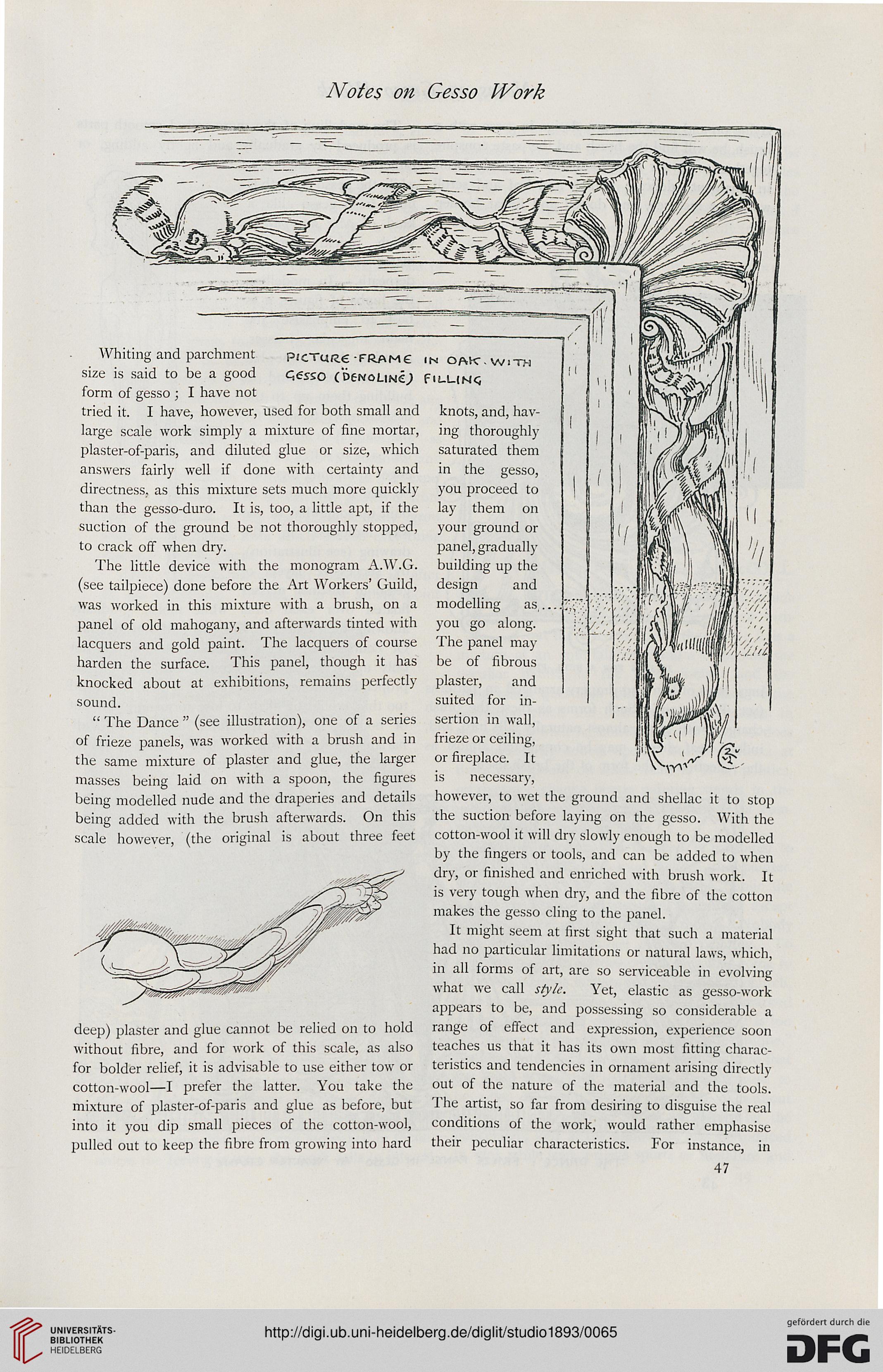Notes on Gesso Work
Whiting and parchment P/cTy^e FRANie in OftK w.-n-i
size is said to be a good Qesso (*6eNOLiNe; f illin<;
form of gesso ; I have not
tried it. I have, however, used for both small and knots, and, hav-
large scale work simply a mixture of fine mortar, ing thoroughly
plaster-of-paris, and diluted glue or size, which saturated them
answers fairly well if done with certainty and in the gesso,
directness, as this mixture sets much more quickly you proceed to
than the gesso-duro. It is, too, a little apt, if the lay them on
suction of the ground be not thoroughly stopped, your ground or
to crack off when dry. panel, gradually
The little device with the monogram A.W.G. building up the
(see tailpiece) done before the Art Workers' Guild, design and
was worked in this mixture with a brush, on a modelling as .
panel of old mahogany, and afterwards tinted with you go along,
lacquers and gold paint. The lacquers of course The panel may
harden the surface. This panel, though it has be of fibrous
knocked about at exhibitions, remains perfectly plaster, and
sound. suited for in-
" The Dance " (see illustration), one of a series sertion in wall,
of frieze panels, was worked with a brush and in frieze or ceiling,
the same mixture of plaster and glue, the larger or fireplace. It
masses being laid on with a spoon, the figures is necessary,
being modelled nude and the draperies and details however, to wet the ground and shellac it to stop
being added with the brush afterwards. On this the suction before laying on the gesso. With the
scale however, (the original is about three feet cotton-wool it will dry slowly enough to be modelled
by the fingers or tools, and can be added to when
dry, or finished and enriched with brush work. It
is very tough when dry, and the fibre of the cotton
makes the gesso cling to the panel.
It might seem at first sight that such a material
had no particular limitations or natural laws, which,
in all forms of art, are so serviceable in evolving
what we call style. Yet, elastic as gesso-work
appears to be, and possessing so considerable a
deep) plaster and glue cannot be relied on to hold range of effect and expression, experience soon
without fibre, and for work of this scale, as also teaches us that it has its own most fitting charac-
for bolder relief, it is advisable to use either tow or teristics and tendencies in ornament arising directly
cotton-wool—I prefer the latter. You take the out of the nature of the material and the tools,
mixture of plaster-of-paris and glue as before, but The artist, so far from desiring to disguise the real
into it you dip small pieces of the cotton-wool, conditions of the work, would rather emphasise
pulled out to keep the fibre from growing into hard their peculiar characteristics. For instance, in
47
Whiting and parchment P/cTy^e FRANie in OftK w.-n-i
size is said to be a good Qesso (*6eNOLiNe; f illin<;
form of gesso ; I have not
tried it. I have, however, used for both small and knots, and, hav-
large scale work simply a mixture of fine mortar, ing thoroughly
plaster-of-paris, and diluted glue or size, which saturated them
answers fairly well if done with certainty and in the gesso,
directness, as this mixture sets much more quickly you proceed to
than the gesso-duro. It is, too, a little apt, if the lay them on
suction of the ground be not thoroughly stopped, your ground or
to crack off when dry. panel, gradually
The little device with the monogram A.W.G. building up the
(see tailpiece) done before the Art Workers' Guild, design and
was worked in this mixture with a brush, on a modelling as .
panel of old mahogany, and afterwards tinted with you go along,
lacquers and gold paint. The lacquers of course The panel may
harden the surface. This panel, though it has be of fibrous
knocked about at exhibitions, remains perfectly plaster, and
sound. suited for in-
" The Dance " (see illustration), one of a series sertion in wall,
of frieze panels, was worked with a brush and in frieze or ceiling,
the same mixture of plaster and glue, the larger or fireplace. It
masses being laid on with a spoon, the figures is necessary,
being modelled nude and the draperies and details however, to wet the ground and shellac it to stop
being added with the brush afterwards. On this the suction before laying on the gesso. With the
scale however, (the original is about three feet cotton-wool it will dry slowly enough to be modelled
by the fingers or tools, and can be added to when
dry, or finished and enriched with brush work. It
is very tough when dry, and the fibre of the cotton
makes the gesso cling to the panel.
It might seem at first sight that such a material
had no particular limitations or natural laws, which,
in all forms of art, are so serviceable in evolving
what we call style. Yet, elastic as gesso-work
appears to be, and possessing so considerable a
deep) plaster and glue cannot be relied on to hold range of effect and expression, experience soon
without fibre, and for work of this scale, as also teaches us that it has its own most fitting charac-
for bolder relief, it is advisable to use either tow or teristics and tendencies in ornament arising directly
cotton-wool—I prefer the latter. You take the out of the nature of the material and the tools,
mixture of plaster-of-paris and glue as before, but The artist, so far from desiring to disguise the real
into it you dip small pieces of the cotton-wool, conditions of the work, would rather emphasise
pulled out to keep the fibre from growing into hard their peculiar characteristics. For instance, in
47




